sensor LEXUS LS600H 2017 Workshop Manual
[x] Cancel search | Manufacturer: LEXUS, Model Year: 2017, Model line: LS600H, Model: LEXUS LS600H 2017Pages: 676, PDF Size: 35.25 MB
Page 352 of 676
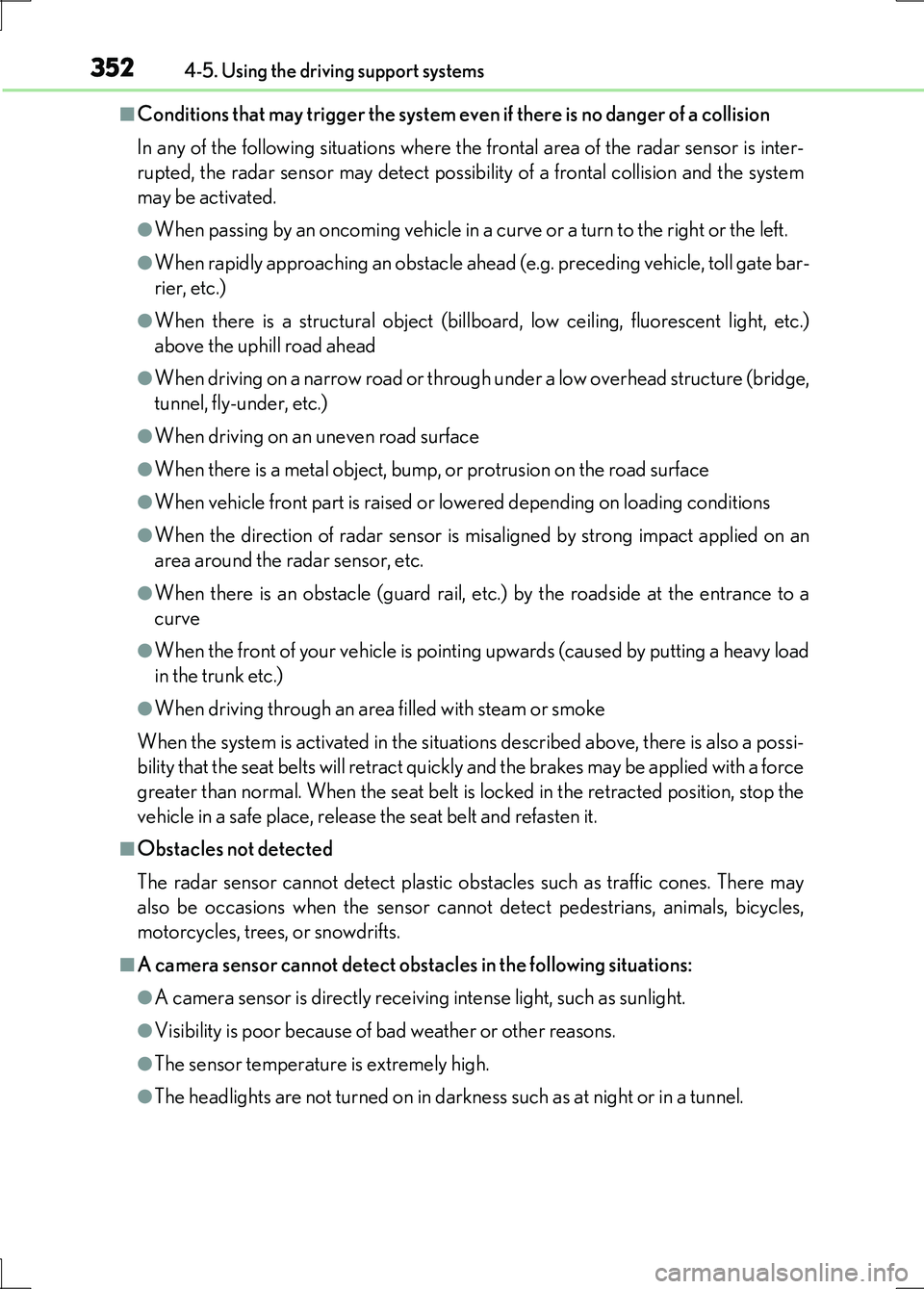
3524-5. Using the driving support systems
LS600h/LS600hL_EE(OM50G20E)
■Conditions that may trigger the system even if there is no danger of a collision
In any of the following situations where the frontal area of the radar sensor is inter-
rupted, the radar sensor may detect possibility of a frontal collision and the system
may be activated.
●When passing by an oncoming vehicle in a curve or a turn to the right or the left.
●When rapidly approaching an obstacle ahead (e.g. preceding vehicle, toll gate bar-
rier, etc.)
●When there is a structural object (billboard, low ceiling, fluorescent light, etc.)
above the uphill road ahead
●When driving on a narrow road or through under a low overhead structure (bridge,
tunnel, fly-under, etc.)
●When driving on an uneven road surface
●When there is a metal object, bump, or protrusion on the road surface
●When vehicle front part is raised or lowered depending on loading conditions
●When the direction of radar sensor is misaligned by strong impact applied on an
area around the radar sensor, etc.
●When there is an obstacle (guard rail, etc.) by the roadside at the entrance to a
curve
●When the front of your vehicle is pointing upwards (caused by putting a heavy load
in the trunk etc.)
●When driving through an area filled with steam or smoke
When the system is activated in the situatio ns described above, there is also a possi-
bility that the seat belts will retract quickly and the brakes may be applied with a force
greater than normal. When the seat belt is locked in the retracted position, stop the
vehicle in a safe place, release the seat belt and refasten it.
■Obstacles not detected
The radar sensor cannot detect plastic obstacles such as traffic cones. There may
also be occasions when the sensor cannot detect pedestrians, animals, bicycles,
motorcycles, trees, or snowdrifts.
■A camera sensor cannot detect obstacles in the following situations:
●A camera sensor is directly receiving intense light, such as sunlight.
●Visibility is poor because of bad weather or other reasons.
●The sensor temperature is extremely high.
●The headlights are not turned on in darkness such as at night or in a tunnel.
Page 353 of 676
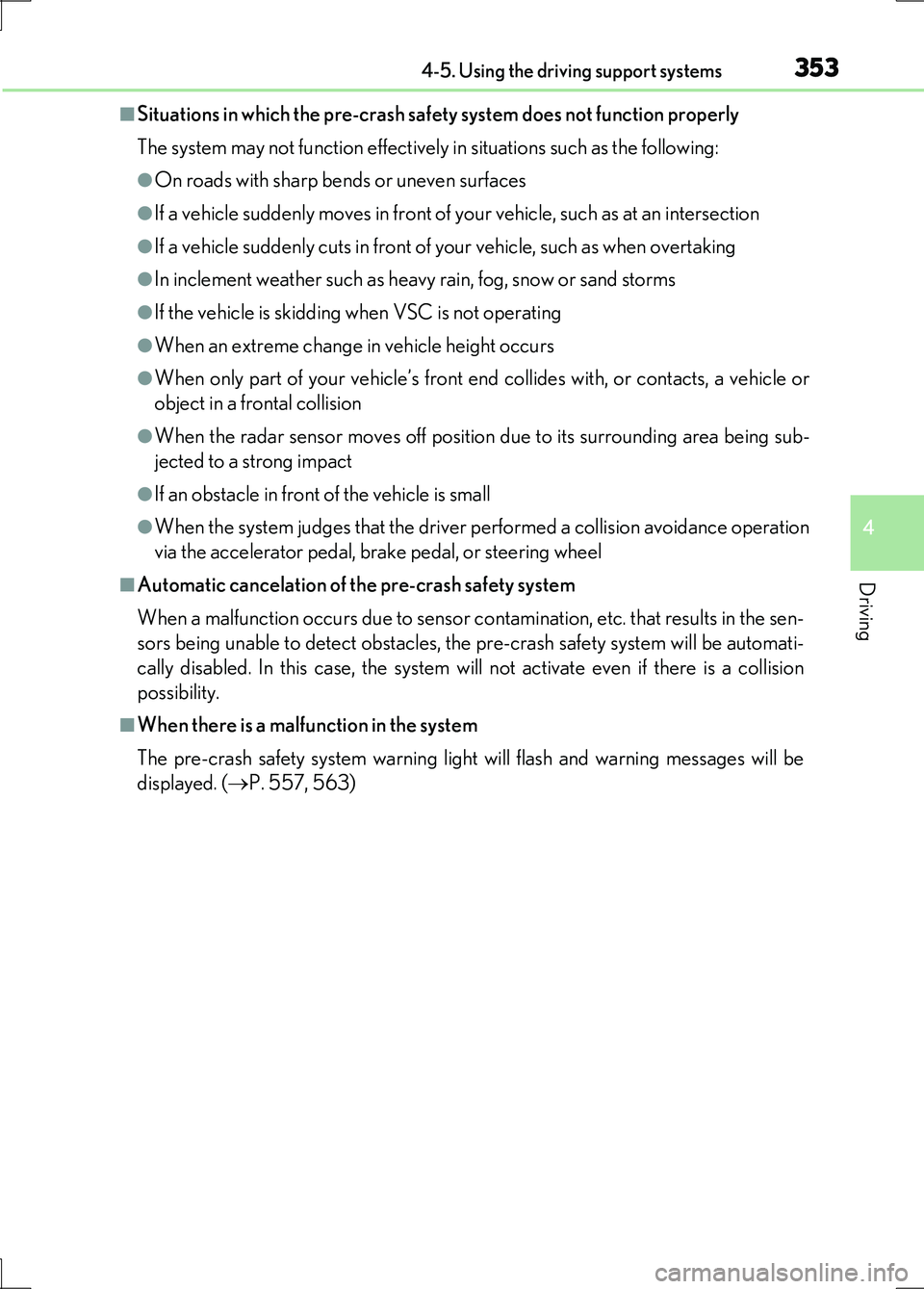
3534-5. Using the driving support systems
4
Driving
LS600h/LS600hL_EE(OM50G20E)
■Situations in which the pre-crash safety system does not function properly
The system may not function effectively in situations such as the following:
●On roads with sharp bends or uneven surfaces
●If a vehicle suddenly moves in front of your vehicle, such as at an intersection
●If a vehicle suddenly cuts in front of your vehicle, such as when overtaking
●In inclement weather such as heavy rain, fog, snow or sand storms
●If the vehicle is skidding when VSC is not operating
●When an extreme change in vehicle height occurs
●When only part of your vehicle’s front end collides with, or contacts, a vehicle or
object in a frontal collision
●When the radar sensor moves off position due to its surrounding area being sub-
jected to a strong impact
●If an obstacle in front of the vehicle is small
●When the system judges that the driver performed a collision avoidance operation
via the accelerator pedal, brake pedal, or steering wheel
■Automatic cancelation of the pre-crash safety system
When a malfunction occurs due to sensor contamination, etc. that results in the sen-
sors being unable to detect obstacles, the pre-crash safety system will be automati-
cally disabled. In this case, the system will not activate even if there is a collision
possibility.
■When there is a malfunction in the system
The pre-crash safety system warning light will flash and warning messages will be
displayed. ( P. 557, 563)
Page 356 of 676
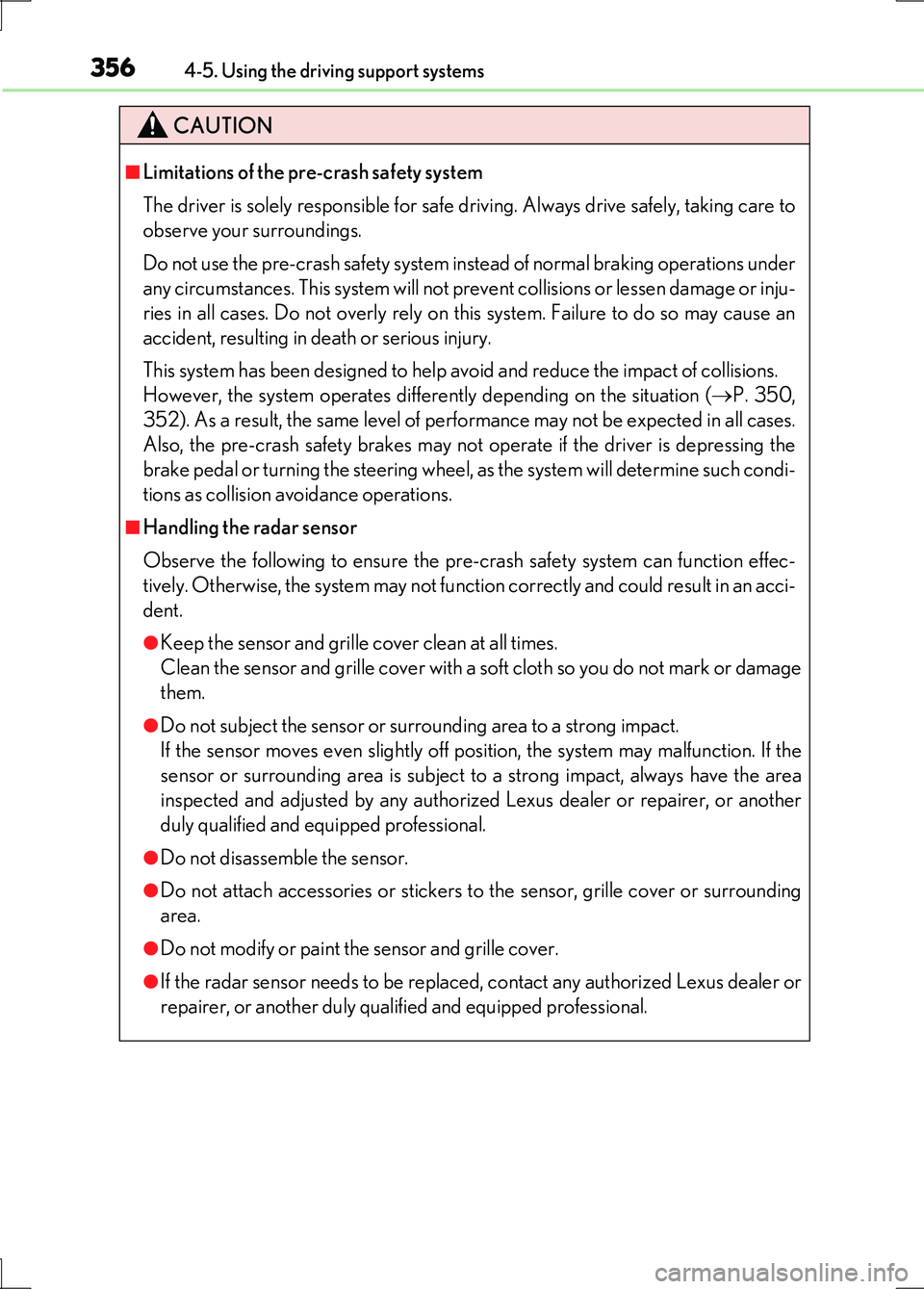
3564-5. Using the driving support systems
LS600h/LS600hL_EE(OM50G20E)
CAUTION
■Limitations of the pre-crash safety system
The driver is solely responsible for safe driving. Always drive safely, taking care to
observe your surroundings.
Do not use the pre-crash safety system instead of normal braking operations under
any circumstances. This system will not prevent collisions or lessen damage or inju-
ries in all cases. Do not overly rely on this system. Failure to do so may cause an
accident, resulting in death or serious injury.
This system has been designed to help avoid and reduce the impact of collisions.
However, the system operates differently depending on the situation ( P. 350,
352). As a result, the same level of performance may not be expected in all cases.
Also, the pre-crash safety brakes may not operate if the driver is depressing the
brake pedal or turning the steering wheel, as the system will determine such condi-
tions as collision avoidance operations.
■Handling the radar sensor
Observe the following to ensure the pre-crash safety system can function effec-
tively. Otherwise, the system may not function correctly and could result in an acci-
dent.
●Keep the sensor and grille cover clean at all times.
Clean the sensor and grille cover with a soft cloth so you do not mark or damage
them.
●Do not subject the sensor or surrounding area to a strong impact.
If the sensor moves even slightly off position, the system may malfunction. If the
sensor or surrounding area is subject to a strong impact, always have the area
inspected and adjusted by any authorized Lexus dealer or repairer, or another
duly qualified and equipped professional.
●Do not disassemble the sensor.
●Do not attach accessories or stickers to the sensor, grille cover or surrounding
area.
●Do not modify or paint the sensor and grille cover.
●If the radar sensor needs to be replaced, contact any authorized Lexus dealer or
repairer, or another duly qualified and equipped professional.
Page 357 of 676
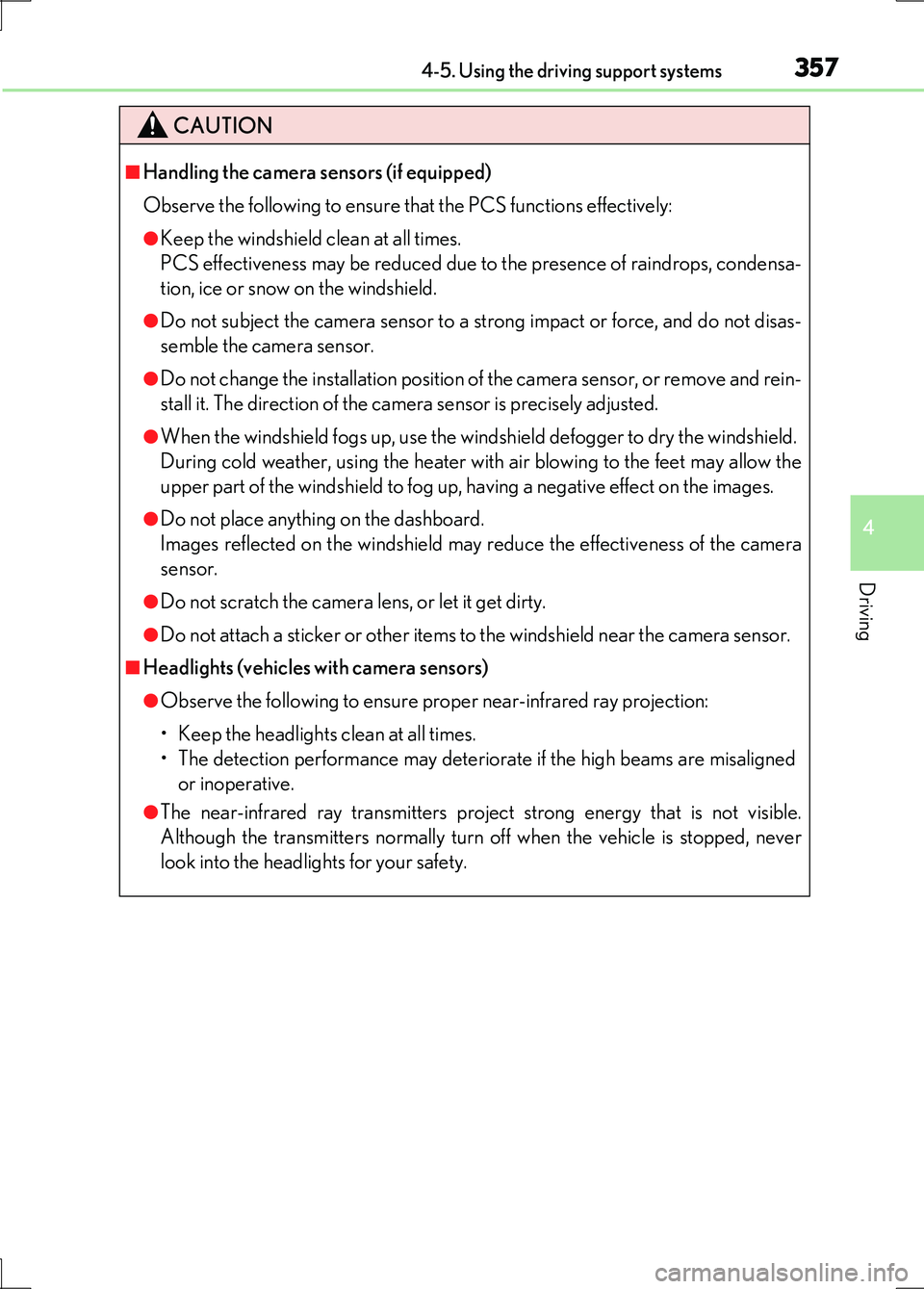
3574-5. Using the driving support systems
4
Driving
LS600h/LS600hL_EE(OM50G20E)
CAUTION
■Handling the camera sensors (if equipped)
Observe the following to ensure that the PCS functions effectively:
●Keep the windshield clean at all times.
PCS effectiveness may be reduced due to the presence of raindrops, condensa-
tion, ice or snow on the windshield.
●Do not subject the camera sensor to a st rong impact or force, and do not disas-
semble the camera sensor.
●Do not change the installation position of the camera sensor, or remove and rein-
stall it. The direction of the camera sensor is precisely adjusted.
●When the windshield fogs up, use the wi ndshield defogger to dry the windshield.
During cold weather, using the heater with air blowing to the feet may allow the
upper part of the windshield to fog up, having a negative effect on the images.
●Do not place anything on the dashboard.
Images reflected on the windshield may reduce the effectiveness of the camera
sensor.
●Do not scratch the camera lens, or let it get dirty.
●Do not attach a sticker or other items to the windshield near the camera sensor.
■Headlights (vehicles with camera sensors)
●Observe the following to ensure proper near-infrared ray projection:
• Keep the headlights clean at all times.
• The detection performance may deteriorate if the high beams are misaligned
or inoperative.
●The near-infrared ray transmitters project strong energy that is not visible.
Although the transmitters normally turn off when the vehicle is stopped, never
look into the headlights for your safety.
Page 358 of 676
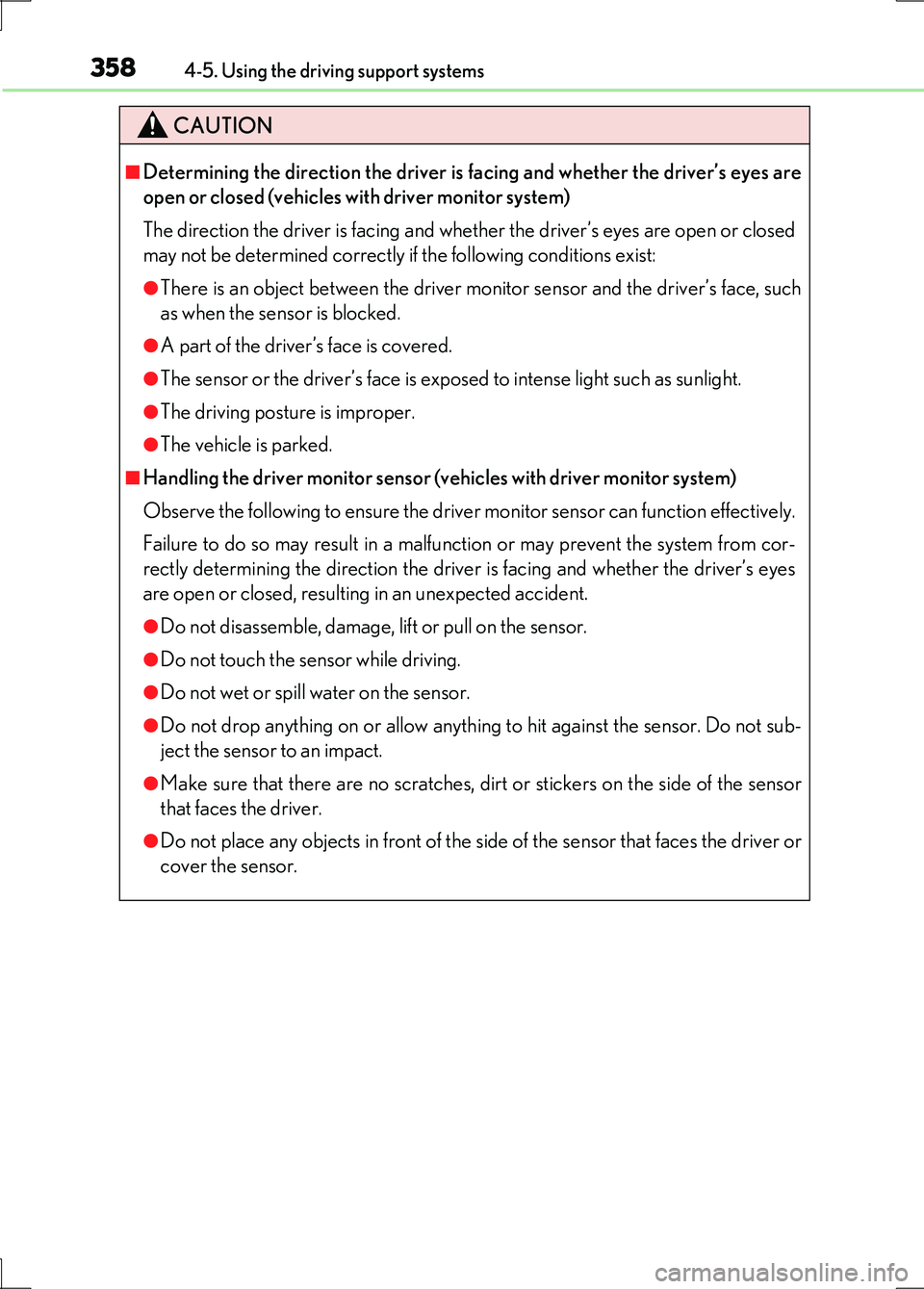
3584-5. Using the driving support systems
LS600h/LS600hL_EE(OM50G20E)
CAUTION
■Determining the direction the driver is facing and whether the driver’s eyes are
open or closed (vehicles with driver monitor system)
The direction the driver is facing and whether the driver’s eyes are open or closed
may not be determined correctly if the following conditions exist:
●There is an object between the driver monitor sensor and the driver’s face, such
as when the sensor is blocked.
●A part of the driver’s face is covered.
●The sensor or the driver’s face is exposed to intense light such as sunlight.
●The driving posture is improper.
●The vehicle is parked.
■Handling the driver monitor sensor (vehicles with driver monitor system)
Observe the following to ensure the driver monitor sensor can function effectively.
Failure to do so may result in a malfunction or may prevent the system from cor-
rectly determining the direction the driver is facing and whether the driver’s eyes
are open or closed, resulting in an unexpected accident.
●Do not disassemble, damage, lift or pull on the sensor.
●Do not touch the sensor while driving.
●Do not wet or spill water on the sensor.
●Do not drop anything on or allow anything to hit against the sensor. Do not sub-
ject the sensor to an impact.
●Make sure that there are no scratches, dirt or stickers on the side of the sensor
that faces the driver.
●Do not place any objects in front of the side of the sensor that faces the driver or
cover the sensor.
Page 359 of 676
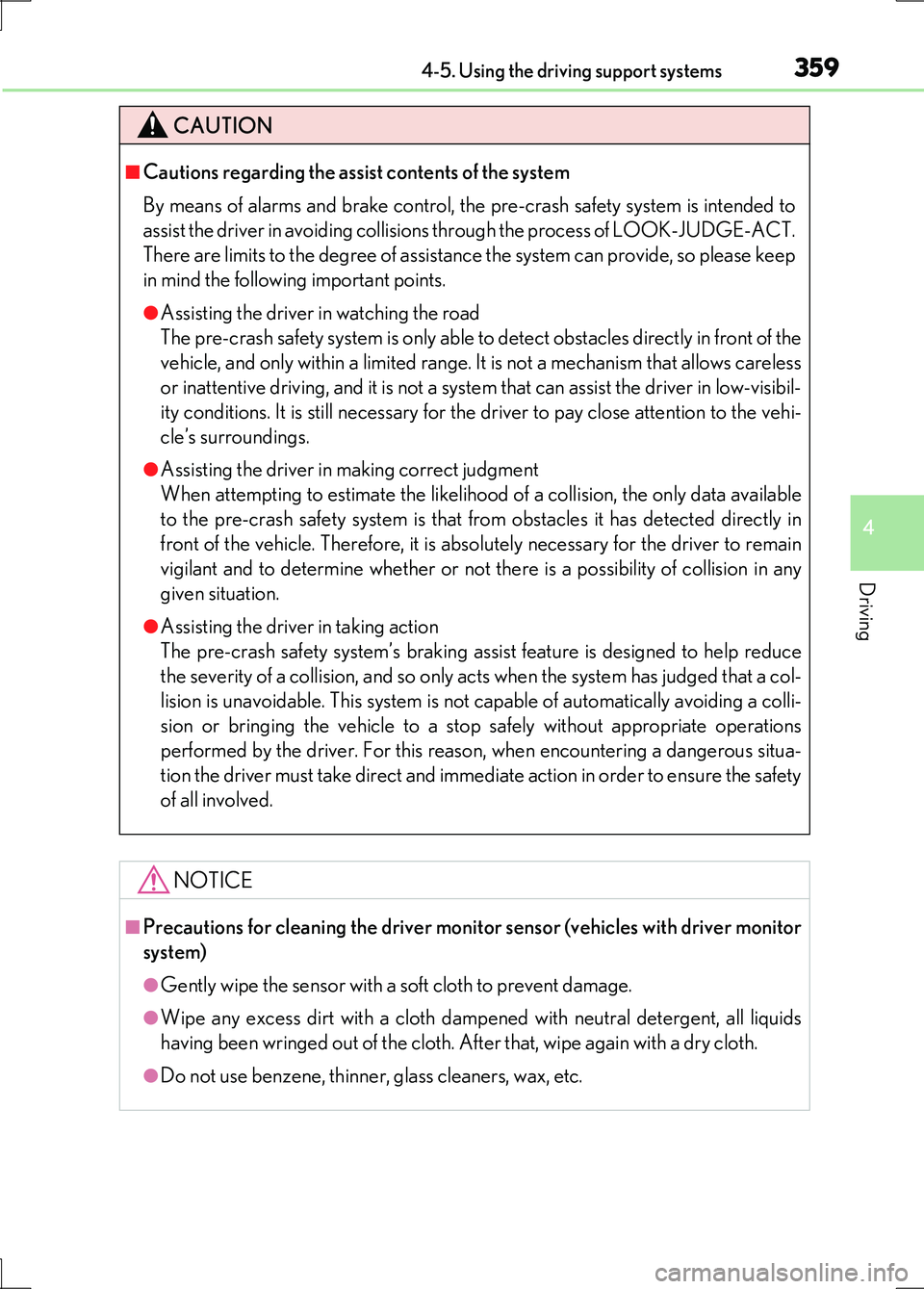
3594-5. Using the driving support systems
4
Driving
LS600h/LS600hL_EE(OM50G20E)
CAUTION
■Cautions regarding the assist contents of the system
By means of alarms and brake control, the pre-crash safety system is intended to
assist the driver in avoiding collisions through the process of LOOK-JUDGE-ACT.
There are limits to the degree of assistance the system can provide, so please keep
in mind the following important points.
●Assisting the driver in watching the road
The pre-crash safety system is only able to detect obstacles directly in front of the
vehicle, and only within a limited range. It is not a mechanism that allows careless
or inattentive driving, and it is not a system that can assist the driver in low-visibil-
ity conditions. It is still necessary for the driver to pay close attention to the vehi-
cle’s surroundings.
●Assisting the driver in making correct judgment
When attempting to estimate the likelihood of a collision, the only data available
to the pre-crash safety system is that from obstacles it has detected directly in
front of the vehicle. Therefore, it is absolutely necessary for the driver to remain
vigilant and to determine whether or not there is a possibility of collision in any
given situation.
●Assisting the driver in taking action
The pre-crash safety system’s braking assist feature is designed to help reduce
the severity of a collision, and so only acts when the system has judged that a col-
lision is unavoidable. This system is not capable of automatically avoiding a colli-
sion or bringing the vehi cle to a stop safely without appropriate operations
performed by the driver. For this reason, when encountering a dangerous situa-
tion the driver must take direct and immediate action in order to ensure the safety
of all involved.
NOTICE
■Precautions for cleaning the driver monitor sensor (vehicles with driver monitor
system)
●Gently wipe the sensor with a soft cloth to prevent damage.
●Wipe any excess dirt with a cloth dampened with neutral detergent, all liquids
having been wringed out of the cloth. After that, wipe again with a dry cloth.
●Do not use benzene, thinner, glass cleaners, wax, etc.
Page 360 of 676
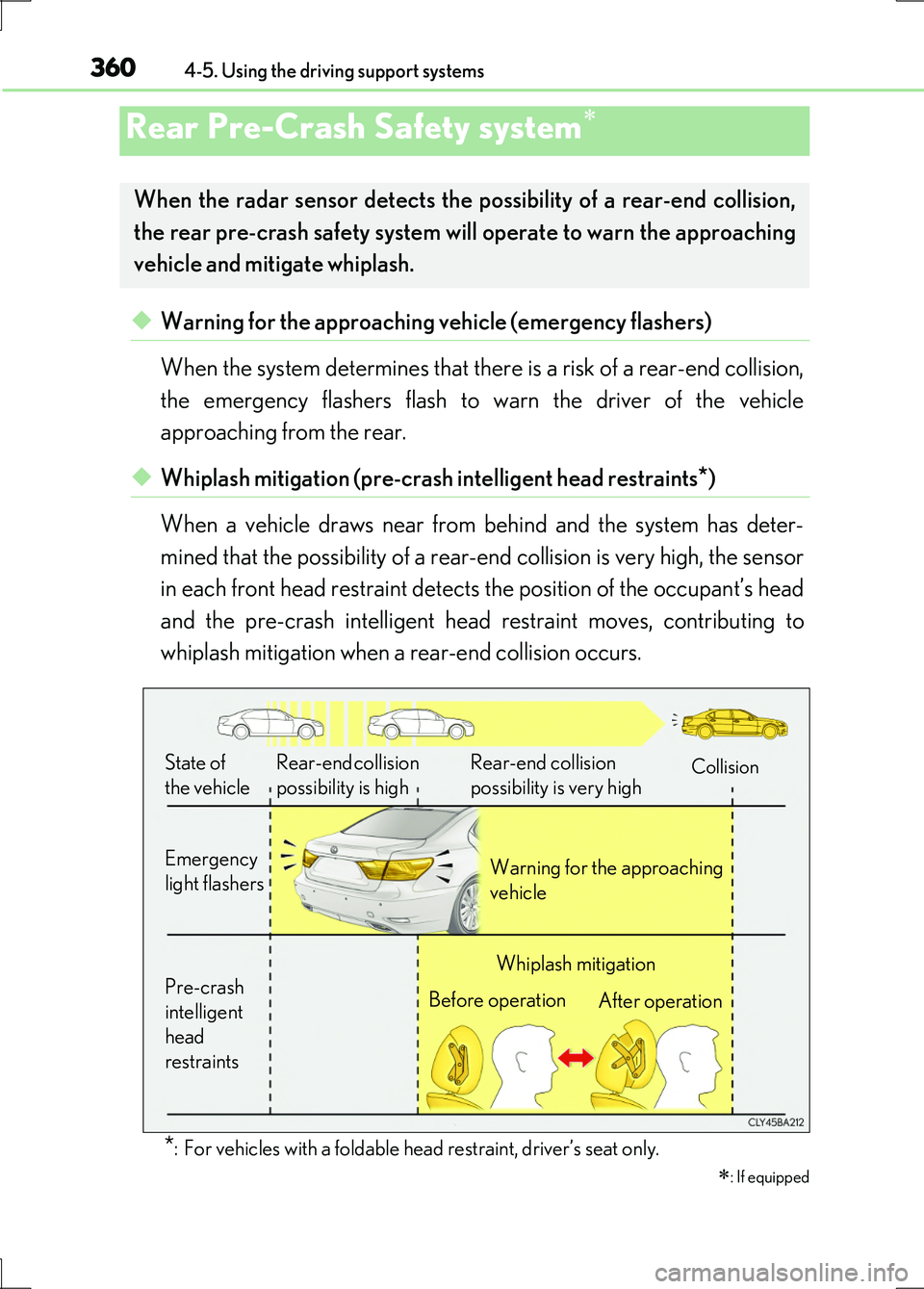
3604-5. Using the driving support systems
LS600h/LS600hL_EE(OM50G20E)
◆Warning for the approaching vehicle (emergency flashers)
When the system determines that there is a risk of a rear-end collision,
the emergency flashers flash to warn the driver of the vehicle
approaching from the rear.
◆Whiplash mitigation (pre-crash intelligent head restraints*)
When a vehicle draws near from behind and the system has deter-
mined that the possibility of a rear-end collision is very high, the sensor
in each front head restraint detects the position of the occupant’s head
and the pre-crash intelligent head restraint moves, contributing to
whiplash mitigation when a rear-end collision occurs.
*: For vehicles with a foldable head restraint, driver’s seat only.
Rear Pre-Crash Safety system
: If equipped
When the radar sensor detects the possibility of a rear-end collision,
the rear pre-crash safety system will operate to warn the approaching
vehicle and mitigate whiplash.
Rear-end collision
possibility is high
Rear-end collision
possibility is very highCollision
Emergency
light flashers Warning for the approaching
vehicle
Pre-crash
intelligent
head
restraints
Whiplash mitigation
Before operation After operation
State of
the vehicle
Page 361 of 676
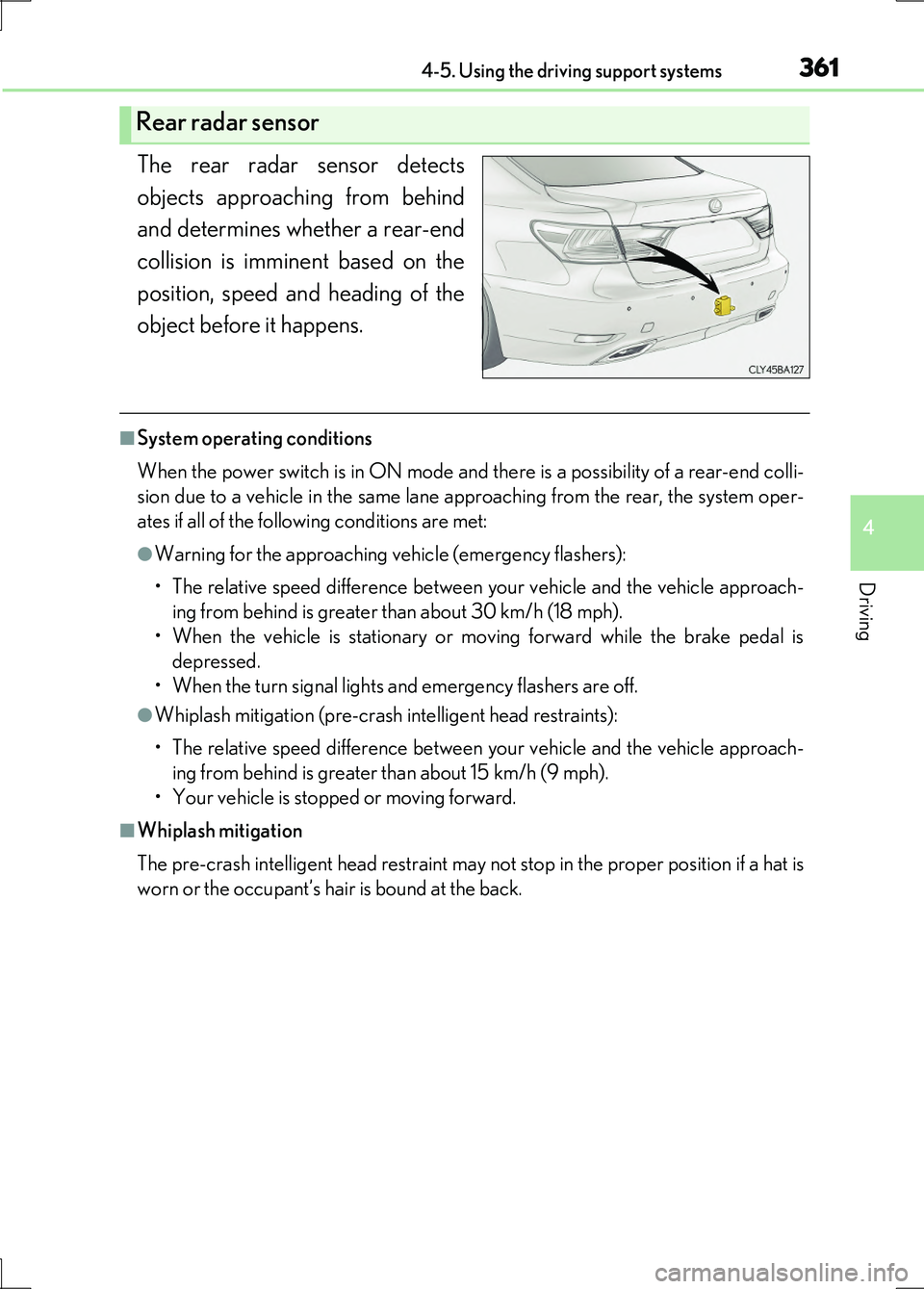
3614-5. Using the driving support systems
4
Driving
LS600h/LS600hL_EE(OM50G20E)
The rear radar sensor detects
objects approaching from behind
and determines whether a rear-end
collision is imminent based on the
position, speed and heading of the
object before it happens.
■System operating conditions
When the power switch is in ON mode and there is a possibility of a rear-end colli-
sion due to a vehicle in the same lane approaching from the rear, the system oper-
ates if all of the following conditions are met:
●Warning for the approaching vehicle (emergency flashers):
• The relative speed difference between your vehicle and the vehicle approach-
ing from behind is greater than about 30 km/h (18 mph).
• When the vehicle is stationary or moving forward while the brake pedal is
depressed.
• When the turn signal lights and emergency flashers are off.
●Whiplash mitigation (pre-crash intelligent head restraints):
• The relative speed difference between your vehicle and the vehicle approach-
ing from behind is greater than about 15 km/h (9 mph).
• Your vehicle is stopped or moving forward.
■Whiplash mitigation
The pre-crash intelligent head restraint may not stop in the proper position if a hat is
worn or the occupant’s hair is bound at the back.
Rear radar sensor
Page 362 of 676
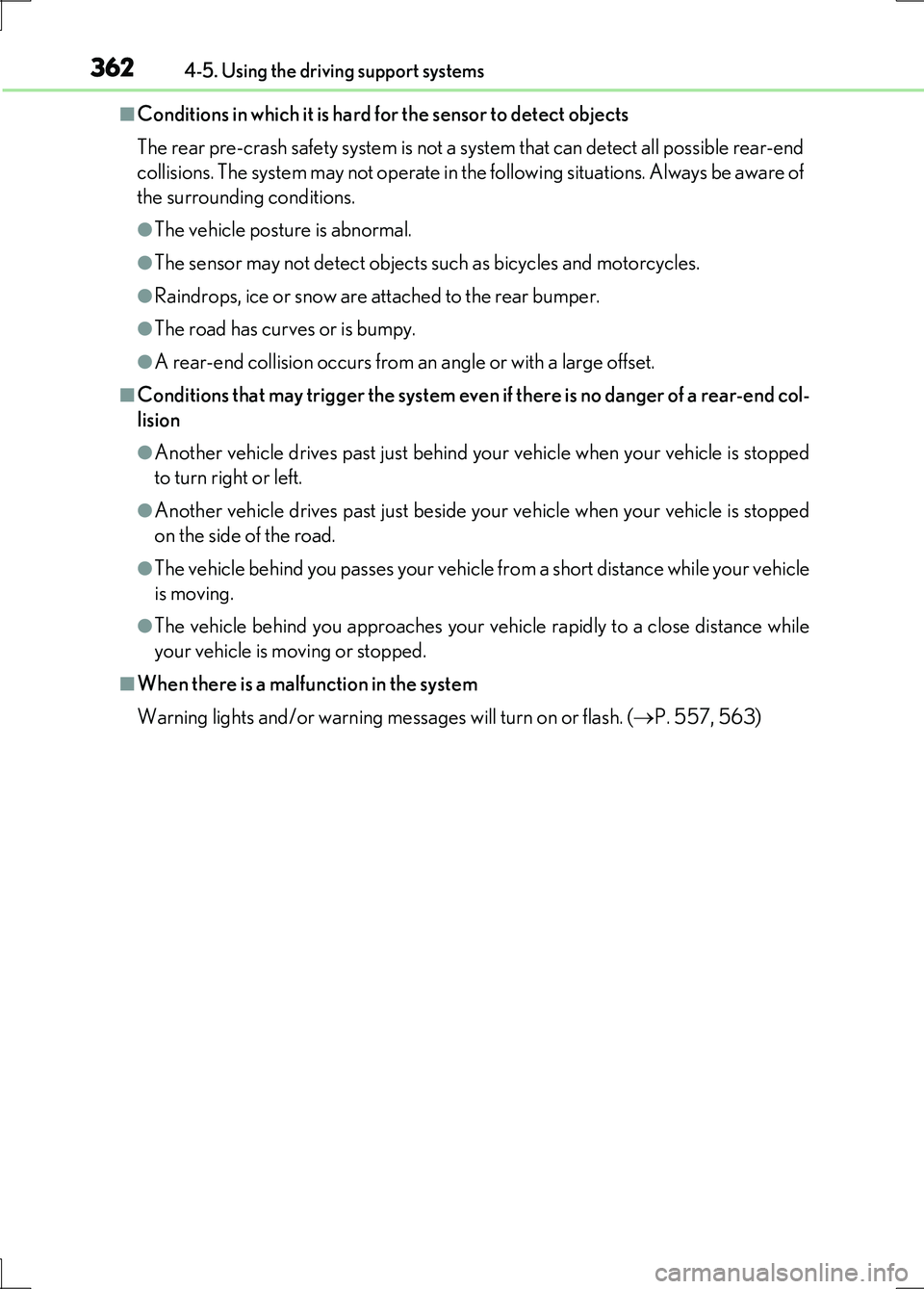
3624-5. Using the driving support systems
LS600h/LS600hL_EE(OM50G20E)
■Conditions in which it is hard for the sensor to detect objects
The rear pre-crash safety system is not a system that can detect all possible rear-end
collisions. The system may not operate in th e following situations. Always be aware of
the surrounding conditions.
●The vehicle posture is abnormal.
●The sensor may not detect objects such as bicycles and motorcycles.
●Raindrops, ice or snow are attached to the rear bumper.
●The road has curves or is bumpy.
●A rear-end collision occurs from an angle or with a large offset.
■Conditions that may trigger the system even if there is no danger of a rear-end col-
lision
●Another vehicle drives past just behind your vehicle when your vehicle is stopped
to turn right or left.
●Another vehicle drives past just beside your vehicle when your vehicle is stopped
on the side of the road.
●The vehicle behind you passes your vehicle from a short distance while your vehicle
is moving.
●The vehicle behind you approaches your vehicle rapidly to a close distance while
your vehicle is moving or stopped.
■When there is a malfunction in the system
Warning lights and/or warning messages will turn on or flash. ( P. 557, 563)
Page 365 of 676
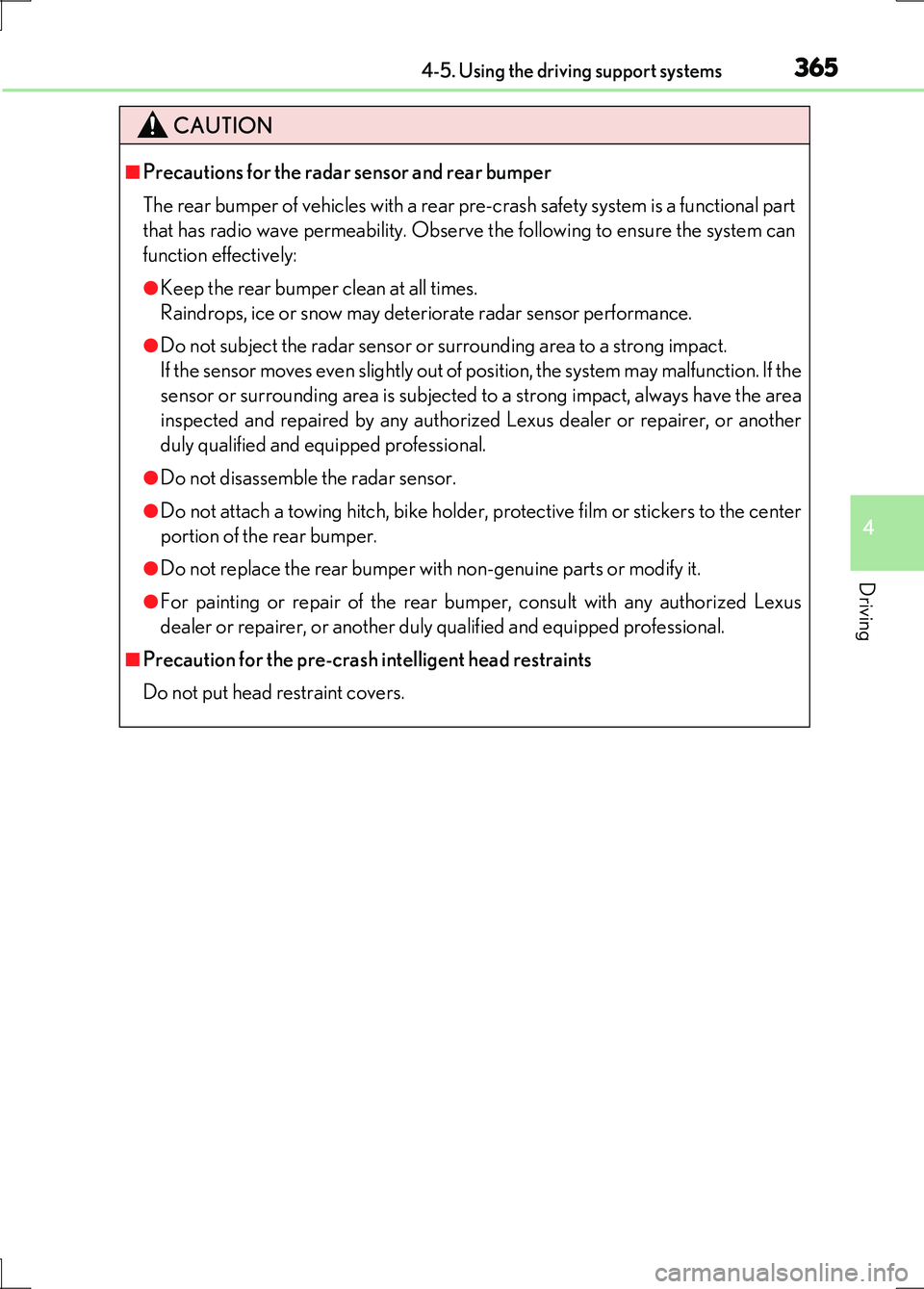
3654-5. Using the driving support systems
4
Driving
LS600h/LS600hL_EE(OM50G20E)
CAUTION
■Precautions for the radar sensor and rear bumper
The rear bumper of vehicles with a rear pre-crash safety system is a functional part
that has radio wave permeability. Observe the following to ensure the system can
function effectively:
●Keep the rear bumper clean at all times.
Raindrops, ice or snow may dete riorate radar sensor performance.
●Do not subject the radar sensor or surrounding area to a strong impact.
If the sensor moves even slightly out of position, the system may malfunction. If the
sensor or surrounding area is subjected to a strong impact, always have the area
inspected and repaired by any authorized Lexus dealer or repairer, or another
duly qualified and equipped professional.
●Do not disassemble the radar sensor.
●Do not attach a towing hitch, bike holder, protective film or stickers to the center
portion of the rear bumper.
●Do not replace the rear bumper with non-genuine parts or modify it.
●For painting or repair of the rear bumper, consult with any authorized Lexus
dealer or repairer, or another duly qualified and equipped professional.
■Precaution for the pre-crash intelligent head restraints
Do not put head restraint covers.